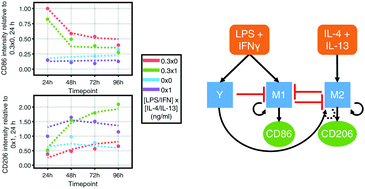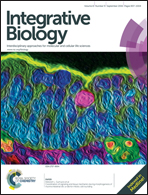Regulation of macrophage polarization and plasticity by complex activation signals†
Abstract
Macrophages are versatile cells of the immune system that play an important role in both advancing and resolving inflammation. Macrophage activation has been described as a continuum, and different stimuli lead to M1, M2, or mixed phenotypes. In addition, macrophages expressing markers associated with both M1 and M2 function are observed in vivo. Using flow cytometry, we examine how macrophage populations respond to combined M1 and M2 activation signals, presented either simultaneously or sequentially. We demonstrate that macrophages exposed to a combination of LPS, IFN-γ, IL-4, and IL-13 acquire a mixed activation state, with individual cells expressing both M1 marker CD86 and M2 marker CD206 instead of polarizing to discrete phenotypes. Over time, co-stimulated macrophages lose expression of CD86 and display increased expression of CD206. In addition, we find that exposure to LPS/IFN-γ potentiates the subsequent response to IL-4/IL-13, whereas pre-polarization with IL-4/IL-13 inhibits the response to LPS/IFN-γ. Mathematical modeling of candidate regulatory networks indicates that a complex inter-dependence of M1- and M2-associated pathways underlies macrophage activation. Specifically, a mutual inhibition motif was not by itself sufficient to reproduce the temporal marker expression data; incoherent feed-forward of M1 activation as well as both inhibition and activation of M2 by M1 were required. Together these results corroborate a continuum model of macrophage activation and demonstrate that phenotypic markers evolve with time and with exposure to complex signals.


 Please wait while we load your content...
Please wait while we load your content...